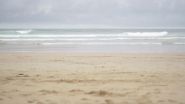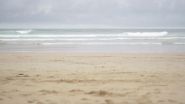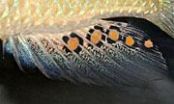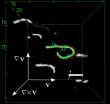Coastal living boosts physical activity
People who live close to the coast are more likely to meet physical activity guidelines than inland dwellers, finds a new study released today
2014-10-09
(Press-News.org) VIDEO:
Learn more about our research into the coast and how it can boost health and wellbeing.
Click here for more information.
People who live close to the coast are more likely to meet physical activity guidelines than inland dwellers, finds a new study released today.
The research involved participants from across England and describes a particularly noticeable effect on western – but unexpectedly not eastern – coasts of the nation.
Publishing their findings in the journal Preventive Medicine, the team from the University of Exeter Medical School analysed data from over 180,000 participants – collected by Natural England.
Examining the amount of exercise people get through leisure activities as well as simply getting around, the study has shown that visiting the coast, rather than just living near it, is crucial in stimulating physical activity.
However, when the researchers broke down the national pattern by region they found that this effect was present in the northwest and southwest of the country but not in any of the east coast regions. Lead author of the study, Dr Mathew White said:
"It's clear that our coastal paths and beaches provide a wonderful resource for encouraging and enabling physical activity. Participants reported a number of activities from simply walking to more obvious exercise such as swimming or running. However, we're unsure why we're only seeing these effects in western regions of the country. Of course, people in the east also exercise but it doesn't seem to be so connected to coastal activities. We might have uncovered untapped potential for east coast resorts and destinations to be used to encourage exercise and promote healthy lifestyles."
The researchers also took into account differences in factors such as age, social status and season, none of which could account for the regional differences in their findings.
Regular exercise can lower the risk of obesity, diabetes, heart disease and depression and plays an important role in keeping people healthy. Current guidelines recommend at least 150 minutes of moderate exercise each week. Recent findings have shown that people living near to the coast are healthier than those living inland and the results published today suggest that higher levels of physical activity could partly explain why.
Dr Ben Wheeler, one of the paper's co-authors said:
"Whilst not everyone can live near a beach, there are around 8 million people in England who live within 5km of the coast. Combined with over 130 million visits a year from those living further inland, it's clear that coastal locations could offer a fantastic opportunity to get more people active. Whilst plenty of questions remain unanswered, our research suggests that government policy needs to ensure these natural spaces are protected and responsibly promoted."
This study is the largest of its kind and the first to be conducted in a European country. It supports results from smaller-scale studies in Australia and New Zealand.
INFORMATION:
[Attachments] See images for this press release:


ELSE PRESS RELEASES FROM THIS DATE:
2014-10-09
Scientists at The University of Manchester have used a new way of working to identify a new gene linked to neurodegenerative diseases such as Alzheimer's. The discovery fills in another piece of the jigsaw when it comes to identifying people most at risk of developing the condition.
Researcher David Ashbrook and colleagues from the UK and USA used two of the world's largest collections of scientific data to compare the genes in mice and humans. Using brain scans from the ENIGMA Consortium and genetic information from The Mouse Brain Library, he was able to identify a ...
2014-10-09
A new measurement of dark matter in the Milky Way has revealed there is half as much of the mysterious substance as previously thought.
Australian astronomers used a method developed almost 100 years ago to discover that the weight of dark matter in our own galaxy is 800 000 000 000 (or 8 x 1011) times the mass of the Sun.
They probed the edge of the Milky Way, looking closely, for the first time, at the fringes of the galaxy about 5 million billion kilometres from Earth.
Astrophysicist Dr Prajwal Kafle, from The University of Western Australia node of the International ...
2014-10-09
PITTSBURGH, Oct. 9, 2014 – National guidelines for the cleaning of certain gastrointestinal (GI) scopes are likely to be updated due to findings from UPMC's infection prevention team.
The research and updated disinfection technique will be shared Saturday in Philadelphia at ID Week 2014, an annual meeting of health professionals in infectious disease fields.
"Patient safety is our top priority," said senior author Carlene Muto, M.D., M.S., director of infection prevention at UPMC Presbyterian Hospital. "We are confident that the change from disinfection to sterilization ...
2014-10-09
PITTSBURGH, Oct. 9, 2014 – UPMC Presbyterian Hospital's infection prevention teams have improved hand washing and sanitizing compliance at the hospital to nearly 100 percent among clinical staff through accountability and educational measures. In a separate effort at UPMC Mercy Hospital, rates of a deadly infection were reduced by educating patients about hand hygiene.
The successful techniques will be reported Saturday in presentations in Philadelphia at ID Week 2014, an annual meeting of health professionals in infectious disease fields.
"Hand hygiene compliance ...
2014-10-09
No matter what type of chemotherapy you attack a tumor with, many cancer cells resort to the same survival tactic: They start eating themselves.
Scientists at Brigham Young University discovered the two proteins that pair up and switch on this process – known as autophagy.
"This gives us a therapeutic avenue to target autophagy in tumors," said Josh Andersen, a BYU chemistry professor. "The idea would be to make tumors more chemo-sensitive. You could target these proteins and the mechanism of this switch to block autophagy, which would allow for lower doses of ...
2014-10-09
The evolution of new traits with novel functions has always posed a challenge to evolutionary biology. Studying the color markings of cichlid fish, Swiss scientists were now able to show what triggered these evolutionary innovations, namely: a mobile genetic element in the regulatory region of a color gene. Their results have been published in the latest issue of the renowned scientific journal Nature Communications.
Biological evolution is in general based on the progressive adaption of traits through natural or sexual selection. However, ever so often, complex traits ...
2014-10-09
Ebola, as with many emerging infections, is likely to have arisen due to man's interaction with wild animals – most likely the practice of hunting and eating wild meat known as 'bushmeat'. A team of researchers led by the University of Cambridge and the Zoological Society of London (ZSL) has surveyed almost six hundred people across southern Ghana to find out what drives consumption of bat bushmeat – and how people perceive the risks associated with the practice.
The Straw-Coloured Fruit Bat, Eidolon helvum, is widely hunted and eaten in Ghana, but carries ...
2014-10-09
Carbon capture is a process by which waste carbon dioxide (CO2) released by factories and power plants is collected and stored away, in order to reduce global carbon emissions. There are two major ways of carbon capture today, one using powder-like solid materials which "stick" to CO2, and one using liquids that absorb it. Despite their potential environmental and energy benefits, current carbon capture strategies are prohibitive because of engineering demands, cost and overall energy-efficiency. Collaborating scientists from EPFL, UC Berkley and Beijing have combined carbon-capturing ...
2014-10-09
Jülich, Germany, 9 October 2014 – When a basically sturdy material becomes soft and spongy, one usually suspects that it has been damaged in some way. But this is not always the case, especially when it comes to complex fluids and biological cells. By looking at the microscopic building blocks – known as "filaments" – of biopolymer networks, researchers from Forschungszentrum Jülich, Germany and the FOM Institute AMOLF in the Netherlands, revealed that such materials soften by undergoing a transition from an entangled spaghetti of filaments to ...
2014-10-09
Some 340 European scientists, policy-makers and other experts representing 143 organizations from 31 countries spoke with one voice today, publishing a common vision of today's most pressing marine-related health and economic threats and opportunities.
In a declaration concluding a three day meeting in Rome, EurOcean 2014 participants also released an agreed, five-year roadmap to achieve expanded, more integrated and effective policy-oriented ocean scrutiny.
EurOcean 2014 was convened by the Italian Presidency of the Council of the European Union, the European Marine ...
LAST 30 PRESS RELEASES:
[Press-News.org] Coastal living boosts physical activity
People who live close to the coast are more likely to meet physical activity guidelines than inland dwellers, finds a new study released today





